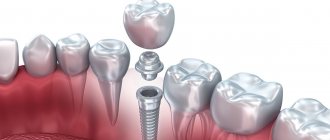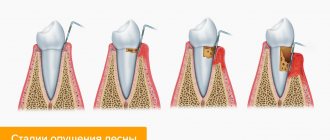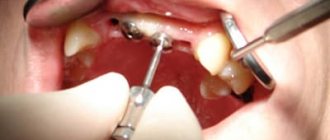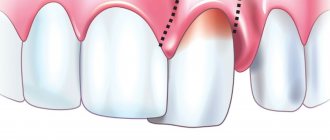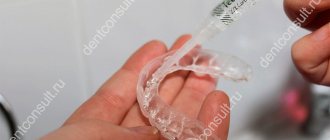Not everyone manages to keep a full set of teeth. Advanced caries, severe destruction of walls, increased inflammatory process are common indications for tooth extraction. In some cases, loss is inevitable, but the defect can be closed.
Dentists recommend installing an implant some time after extraction. It is a multi-component structure that is implanted into the bone tissue of the jaw. An artificial tooth replaces a lost one, helps distribute the chewing load evenly and restores the beauty of your smile. However, implantation does not always go smoothly. Let's look at what problems you might encounter and how to fix them.
Why is the gum exposed under the implant?
Implant exposure is a fairly common occurrence. More common with two-stage implantation. A characteristic sign is the exposure of the metal rim of the abutment under the prosthesis, resulting in the formation of a black stripe . Usually the defect makes itself felt some time after the operation.
Common causes of complications:
- using an implant with a polished neck that remains above the bone surface after screwing in;
- too thin mucous membrane;
- overtension of the gingival flap;
- temporary crown pressure;
- poor quality oral care after implantation;
- mechanical trauma to the gums (toothbrush, hard food);
- improper formation of the gingival margin;
- subsidence of the bone as a result of long-term use of artificial teeth.
Signs of implant failure
You can independently, even before an examination in the office and diagnostics, feel and determine that something is wrong with the implant, for example, the artificial root has lost stability. In this case, it is worth visiting the doctor who performed the operation and installation of the orthopedic structure. It is strictly not recommended to delay your visit.
Signs of peri-implantitis on x-ray
Symptoms:
- swelling and redness of the gums around the implanted tooth that does not go away 5 days after surgery;
- pain that does not depend on pressure, but is constantly present. It’s worse if painkillers don’t help;
- bleeding of the socket, discharge of ichor for several days;
- the appearance of pus with light pressure;
- breath odor (putrid);
- loose fit of soft tissue to the titanium pin, feeling that the implants have come out of the gums;
- elevated temperature for several days (more than 3-4) or that occurs after a seemingly calm state;
- obvious wobbling, mobility of the rod implanted into the bone and its parts: the crown from the implant, the plug, and the gum former have come off.
If you are concerned about one or more symptoms, consult your doctor. The success of osseointegration is in most cases visible in the first weeks to a month
.
Therefore, this period and all the patient’s sensations are very important, not to miss complications that are easier to cure, correct now and prevent the implants from falling out later. The final indicator of engraftment is complete stability of the artificial root, normal color and condition of the gums around after 2-6 months
, also regular visits to the surgeon and photographs, if necessary, will help keep the situation under control.
What methods are used to treat recession?
Gum recession is manifested by exposure of the root system. The problem negatively affects the appearance and is fraught with the development of pathologies.
In dental practice, there are two ways to treat recession:
- Elimination of the defect using soft tissue plastic surgery . This allows you to adhere to the two-step technique, as well as prevent the development of the infectious process. However, surgery cannot be avoided. Plastic surgery is performed by augmenting the gums.
- Transition to a one-stage operation protocol. The plug is removed and an abutment is placed in its place. This option does not guarantee the possibility of infection and loosening of the implant, since a two-stage implantation method was initially chosen.
Why do implants fall out or become loose?
It is very rare for artificial dental implants to become loose or fall out altogether. But doctors are faced with such pathologies and hasten to assure patients that such a situation is unpleasant, but not catastrophic. The problem is solvable. But it’s even better to initially approach the choice of a clinic responsibly, read reviews, recommendations and go to a rated dentistry that works according to European standards. Common reasons for rejection:
- The installation was carried out without taking into account jawbone defects. This may be due to imperfect diagnosis or inexperience of the dentist.
- Injuries resulting in displacement of the structure.
- Failure to comply with doctor's orders. Usually, after surgery, medications are prescribed to prevent complications. If you ignore this point, the body may not cope with stressful processes on its own.
- Medical errors made during the insertion of dental implants.
- Excessive stress during the healing period.
The pathology may also be caused by the rapid development of somatic and endocrine diseases after the installation of the prosthesis. This is diabetes, systemic disorders leading to destructive changes in the tissues of the body.
Plastic surgery of soft tissues if a dental implant has come out of the gum
The procedure for correcting the gingival contour and improving the structural and functional state of the periodontium is called gingivoplasty . Allows you to restore the aesthetic appearance of the jaw when implants are exposed in case of recession.
When and in what cases is it carried out?
After implantation, the patient may experience mucosal deficiency and incomplete coverage of the surface of the titanium rod. It looks ugly and causes a deep feeling of discomfort. Plastic surgery of soft tissues is a reasonable way out of this situation. It is indicated if:
- there is a strong tension on the flap;
- the installed crown puts pressure on the gum, blocking its growth around the implant;
- The patient suffered an injury during hygiene procedures or eating food that requires surgical correction.
The procedure has certain risks. Sometimes the doctor has to put a plug on the artificial root. This does not guarantee that infection cannot enter the bone bed. When the rod is exposed, the development of resorption of bone structures is possible.
How is surgery performed if the implant is visible from the gums?
The goal of gingivoplasty is to build up the mucosa to completely cover the surface of the implant. This is done by adding your own tissues from other parts of the oral cavity. The operation is performed by a periodontist under local or general anesthesia, at the patient’s choice.
Before the procedure, a preparatory stage must be carried out, including the elimination of caries, relief of existing inflammatory processes, and removal of tartar.
Extension is carried out:
- in a selected area, usually the palate, a flap of mucous membrane is peeled off;
- applied to the exposed area;
- bone correction is performed if necessary;
- stitches are placed.
Afterwards the graft engraftment stage begins. After 10 days, the sutures are removed, and when tissue fusion is complete, the gum is incised to gain access to the structure and change the former to the abutment.
Possible complications
Gingivoplasty, like any surgical procedure, has its risks. Complications include:
- development of an allergic reaction to the administered anesthetic;
- recurrence of gum recession (requires re-building after 5-6 months);
- swelling of the operated area;
- painful sensations;
- bleeding;
- hematomas.
This is due to the abundant blood circulation of the tissues of the maxillofacial area. Therefore, with the slightest surgical intervention, especially on the lower dentition, severe swelling and bruising appear, which are not as dangerous as they look. After a couple of days their severity decreases, and after a week or two there is no trace left of them.
The appearance of pain in the first hours after the procedure is considered normal. It can be easily managed with analgesics. If the painful sensations increase and do not go away three days after gum growth, then you need to consult a doctor. Perhaps we are talking about the development of a serious pathological process.
Minor bleeding is acceptable in the first hours after the intervention. Intense hemorrhage, in addition to injury to a large vessel, may indicate a blood clotting disorder, which is dangerous. Preoperative examination, including this indicator, is important.
Numbness of the face after the anesthesia wears off is a rare but unpleasant phenomenon. This is a sign of serious nerve damage. Restoring its functions usually takes at least 4 months and requires treatment.
Symptoms of peri-implantitis
With peri-implantitis, there is a progressive loss of bone tissue. Patients complain of pain in the area of the installed implant, swelling, hyperemia and bleeding of the peri-implant gum; the formation of gingival pockets and fistulas, from which purulent contents can be released.
As inflammation and bone resorption progress, the implant becomes mobile and loses its function. With grade 3-4 peri-implantitis, there is a fairly high probability of implant rejection. Symptoms of peri-implant inflammation can occur both in the immediate period after implantation and in the long term (after many months and even years).
Peri-implantitis is characterized by:
- pain in the implant area,
- hyperemia and swelling of the gums,
- formation of a gum pocket,
- bleeding or suppuration,
- mobility of the implant structure or implant system.
In its development, peri-implantitis goes through 4 stages
First stage
peri-implantitis is characterized by a slight loss of bone tissue in the horizontal direction;
The onset of the second stage
peri-implantitis is characterized by a moderate decrease in bone height with the formation of a vertical defect in the area where the implant connects to the bone;
In case of the third stage
peri-implantitis, we observe a moderate decrease in bone height with the formation of a vertical defect along the entire implant;
Fourth
, the last stage of peri-implantitis, is characterized by bone resorption of the alveolar process.
Implantation using a one-stage installation method - solving the problems of implant exposure
The one-stage method of installing an artificial tooth is popular due to the immediate aesthetic result. The procedure is carried out in one stage, including the following actions of the doctor:
- examination of the patient for contraindications;
- sanitation of the oral cavity, elimination of existing problematic issues;
- removal of the desired tooth;
- preparing a bone bed for a titanium root;
- screwing in the implant;
- installation of abutment and temporary crown.
Once healing is complete, the temporary prosthesis will be replaced with a permanent one.
What to do if a dental implant falls out
When the first signs appear, you should immediately contact your dentist. Under no circumstances should you wait for a dental implant to fall out completely. The longer the inflammation lasts, the more bone tissue is destroyed, which can cause problems with re-implantation.
To determine the exact cause of hair loss and prescribe effective treatment, a set of diagnostic tests is required: examination, x-rays, biological tests, computed tomography, studies for allergic reactions, etc.
If inflammation and infections are detected, it is necessary to completely eliminate the disease, otherwise it will lead to complete rejection of the implant.
The treatment method depends on the cause of the complications and usually includes taking antiseptic and antibiotic drugs.
What to do to prevent receding gums after implant placement
You can avoid unpleasant situations by following simple rules:
- take medications prescribed by the doctor in a timely manner;
- rinse your mouth regularly with antiseptic solutions;
- treat the operated area with care;
- stop smoking;
- do not eat hard, sour, hot, cold foods;
- avoid thermal procedures, such as baths, saunas, hot baths;
- treat sutures with a special ointment prescribed by a doctor;
- brush your teeth twice a day (in the morning - after breakfast, in the evening - before bed);
- use an irrigator, floss.
To identify problem areas in a timely manner, you should visit your dentist periodically.
Prevention of gum recession after implantation
To prevent the development of unpleasant complications, you should follow simple rules:
- follow the recommendations prescribed after implantation;
- maintain oral hygiene, use an irrigator;
- avoid injury to the implantation area;
- stop smoking;
- avoid overheating in the first days after surgery;
- treat the seams with special means prescribed by the doctor;
- maintain oral hygiene.
In addition, you should regularly visit the dentist for preventive examinations, which will allow you to identify any complications in the early stages and begin treatment on time.
